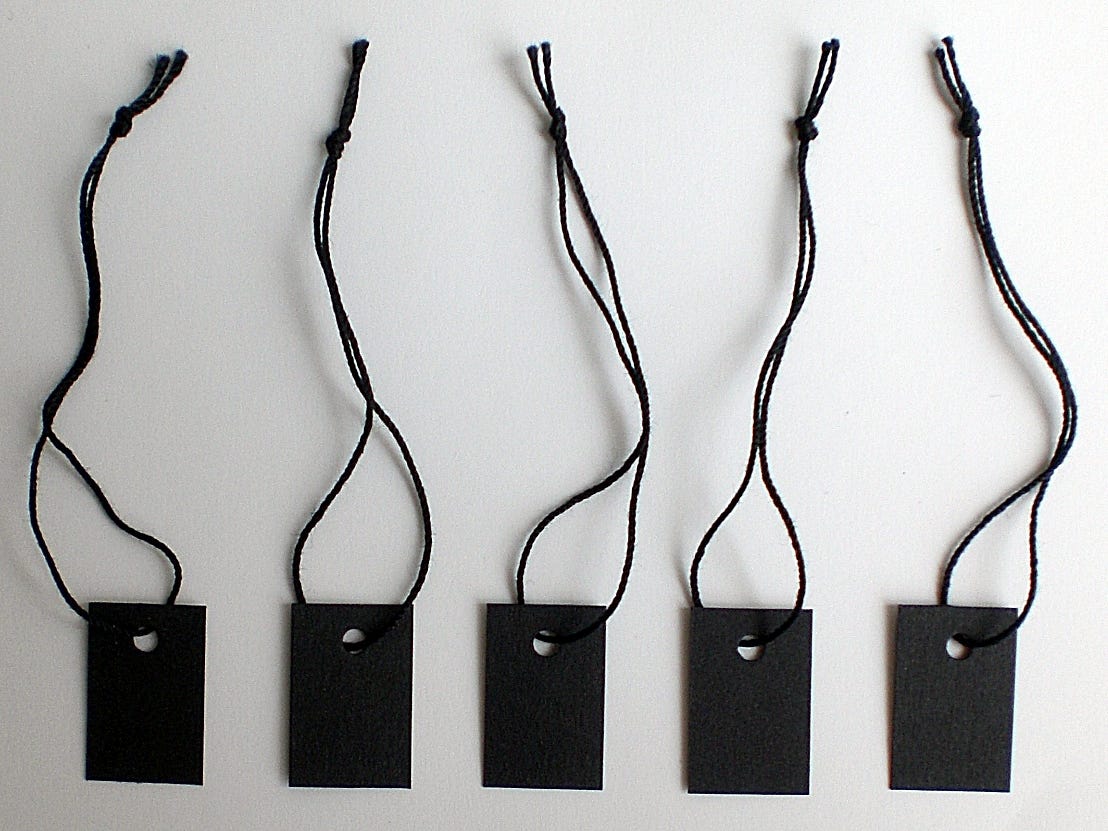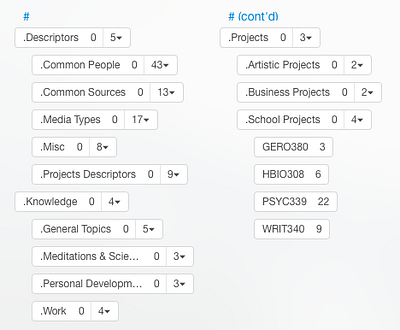
Why the tagging concept in Evernote and everywhere else sucks
By Tiago Forte of Forte Labs
This post was republished on the Evernote blog
There is an axiom in the productivity world that goes something like this:
“Tags are inherently superior to folders”
The reasons seem compelling at first glance:
- Tagging allows the same files/notes/items to exist in more than one place at once, without duplication
- It is faster to type (and autofill) tags than to click and drag something into a folder
- Tags allow you to pull up unique, on-the-fly combinations (such as year + person, document type + topic, project + location, etc.)
Now let me explain why these pros, although theoretically real, are overwhelmed by a tidal wave of cons.
I will use Evernote as an example, but the principles apply anywhere you see tagging.
Decision Fatigue
First, relying primarily on a tagging system to organize notes necessarily requires you to make multiple decisions about each and every note that enters the system.

For example, as Michael Hyatt explains in his oft-cited (and imitated) post How I Organize Evernote (and Thomas Honeyman echoes in his more recent Medium post), he has to tag every note as to What, When, Who, and decide whether it receives one (or multiple) of 64 separate Reference tags, and/or one of the handful of Miscellaneous tags.
Ok, right there, you’ve invested a ton of energy into making multiple non-trivial decisions about something you haven’t even decided is important or worth keeping. This is the whole reason your workflow is a funnel with a wide top and narrow bottom — to make sure you are investing time and energy only in things that deserve it.
And note that this is in no way optional: without notebooks, the tags are the only form of structure, and even a single note without a single category of tags has the potential to fall through the cracks.

“But I’ve memorized my tags!” you say. First of all, you’re relying on one of the few things your brain is worse than machines at — remembering stuff. Second, any change in your current projects, collaborators, priorities, interests, etc. breaks this system. This is the opposite of antifragile. It’s superfragile.
Any system with an upfront access cost this high is just asking to break. This alone, in my opinion, makes tags not worth using.
But there’s more. Oh God there’s more.
Memory Fatigue
Your brain is great at recognition, pretty terrible at recall. It outperforms the fastest supercomputers on the former, and is outdone by a 1980’s solar calculator on the latter.
When you rely heavily on tags, you have to perfectly recall every single tag you’ve ever used, and exactly how it is spelled and punctuated. “Parent” tags that create dropdown menus are no solution — that just leaves you squinting at a tiny list of options to choose from. See above.
And autofill also doesn’t address this — first because it doesn’t work on every device, and second because sometimes there are very different ways of formulating the same thing (graphic design, UX design, interaction design…)
As good as your brain is at recognizing patterns, it is terrible at storing and recalling multiple patterns precisely, since the patterns of neuronal activation interfere with each other. Yet this is exactly what you’re doing with tags. What a terrifically unnecessary expenditure of mental resources.
Lack of Stigmergy
One of the most important discoveries in cognitive science in recent years is that cognition is embodied and situated.
This means that our primary mode of thinking is not manipulating abstract symbols (like a computer does), but rather using our body (thus embodiment) to directly interact with the environment (which is situated). In this way, we “offload” some of our cognitive processing onto our environment, which is after all capable of storing information much better than our brains are.
This is one way that memory grandmasters train. By associating information to be memorized with specific locations, they harness the brain’s vast location-dependent memory. Think about it: memorizing a phone number without constant review is a challenge, yet you can probably identify the locations of hundreds of objects in your house.
This concept is called stigmexrgy (or stigmergic cognition) and represents one of our brains’ greatest innovations in saving energy.
Yet tags completely disregard stigmergy and instead force us to think about our notes in a completely abstract way — as virtual holograms existing in multiple parallel and complex interconnecting universes, instead of as physical objects residing in a single physical location (even if that location is a notebook or other metaphor). The “limitation” of notes residing “only” in a single location is in fact a strength!
Perverse Affordances
In design, you create affordances when you want your user to do something, and disturbances when you want them to not do something. Thus you encourage desired behaviors by making them easier, and discourage undesired behaviors by making them harder.
So which behaviors are desired and undesired when it comes to organization? In any organizational system, the constant temptation is to overorganize, i.e. to create too many categories, too many subdivisions that are too specific. As the number of tags grows arithmetically, their complexity grows geometrically, for multiple reasons, both technological and cognitive (see memory fatigue above). This phenomenon is all the more problematic with unlimited digital information that never runs into physical constraints.
Yet in Evernote and most tagging systems, all it takes to create a new tag is to type one. If the tag is not recognized as already existing, it is created.
Thus the most problematic behavior is implicitly encouraged and enabled. Grrrrrrr. It could be a misspelling. It could be a slip of the finger. It could be a different capitalization, punctuation, or tense, whatever. No warning or indication is given, and a divergent tag is created, for you to hopefully notice and fix later, hopefully before you rely on it.
Over-optimization
Speaking of over-optimization, tags are the poster child.
I theorize that the mentality behind using tags to create hyper-specific targeted searches (“.conversations I had with *girlfriend about ^butternut_squash while wearing #shorts”) comes from the mainframe age, when “running a search” required, basically, writing a custom program that took hours or days to run.
In that case, the transaction cost of running another search was so high, that accuracy was paramount.
But everything’s changed. Notes are stored locally so there is no lag, search is blazing fast, and the search bar provides recommendations and suggestions that are far more accurate and helpful than tags.
In this new paradigm, who cares if I can instantly narrow down my target using obscure criteria the very first time? If I fail to find the conversation I’m looking for by typing “shorts,” I’m sure I’ll find it by typing “butternut squash” or some other combination of terms. It comes down to a simple equation:
energy required to tag every note > energy required to run multiple searches
We’ve reached the point where search is so good, effectively the whole document is made up of tags, and the cognitive load of meticulously tagging every note becomes truly unforgivable.
Intimidation
If you are still with me, greetings fellow productivity nerd! This stuff is the very definition of minutiae. You may be wondering, “Does this really matter?”
I could say something about efficiency and productivity and multiplying one second saved by 3 gazillion and yada yada yada. But I think there’s something deeper here.
I used to think that the point of Evernote (and Dropbox, and Finder, and all the other filing or note-taking systems) was to store important information. But working with people from very different backgrounds, from one-on-one to groups to thousands at a time online, I’ve come to realize that these systems are about much more than functional utility.
They enable one of the most important aspects of any self-driven endeavor: what I call creative self-esteem.
Ask yourself this: when you have an idea, any idea, what do you do with it? Do you obsessively write every single one down, but never look at them again? Or do you let it pass, thinking “Well it probably wasn’t that good of an idea anyway”? Both these extremes represent people with low creative self-esteem — they don’t put much stock in their own ideas.
The real potential of a digital organizational system is to be a tool for capturing and systematically reminding you of past ideas, inspirations, insights, and connections. The heart of creativity and innovation is making spontaneous connections between seemingly unrelated things, and products like Evernote can, when used correctly, serve as a cognitive exoskeleton, both protecting us from the ravages of forgetfulness and amplifying our blows as we take on creative challenges.
The real problem with tags, and why they not only fail to help, but actually even hurt people’s creative self-esteem, is that they give the impression that creating such a system requires a heroic feat of comprehensive planning, followed by years of meticulous, unwavering cataloging and annotating. Thus I see many creative people, justly overwhelmed at this task for which their minds are not well suited, give up on the idea altogether.
Don’t worry about creating the perfect system, as if that exists. Just start capturing. Your mind, noticing you start to record and value your ideas, will respond in kind and start producing more. Begin the cycle, and eventually, maybe, one of those great ideas that will occur to you down the road will reveal the “perfect” system for you.
When I look at successful people, I notice again and again that it is this — the ability to systematically capture and review and deploy their ideas, further strengthening their creative self-esteem, leading them to value and generate more ideas, and so on in a virtuous loop — that really sets them apart. Not the original quantity or quality of ideas, not their brilliance from birth, not luck.
The best of the best use organizational systems as a means to a very worthy end: to create rapid, self-reinforcing learning and feedback loops aimed in the direction of their goals.
And it all starts by getting rid of tags.
Source: I rely heavily in this post on the excellent paper Getting Things Done: The Science behind Stress-Free Productivity from the Free University of Brussels
Follow us for the latest updates and insights around productivity and Building a Second Brain on Twitter, Facebook, Instagram, LinkedIn, and YouTube. And if you're ready to start building your Second Brain, get the book and learn the proven method to organize your digital life and unlock your creative potential.
- POSTED IN: Building a Second Brain, Note-taking, Organizing, Technology
